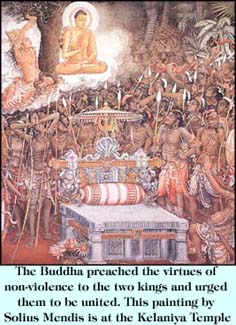 |
 28th March 1999 |
Front Page| |
The Buddha's second visitBy D C RanatungaMahiyanganam Nagadipam Kalyanam Padalanchanam - Thus begins the stanza listing out the Solosmasthana, the sixteen Buddhist places of veneration in our country, believed to have been hallowed by the Buddha. According to the chronicles, the Buddha visited Sri Lanka thrice. His first visit was to Mahiyangana nine months after attaining Enlightenment. The second visit, five years after Enlightenment was to Nagadipa, the name given in the Mahavamsa to the entire Jaffna Peninsula. The third and final visit was to Kelaniya eight years after Enlightenment.
Mahodara wanted to take possession of it. When Buddha came over from Jetavanarama in the city of Sravasti, He was accompanied by God Sumana , a protective deity residing on a tree at the entrance to the Vihara. According to legend, he was a resident of Nagadipa in his previous birth and had provided some Pacceka Buddhas with leaves from a tree to clean their alms bowls. The merit he acquired from that deed had made him a deity. The Buddha preached the virtues of non-violence to the warring factions. He urged them to forget hating each other and be united. The two kings surrounded by their followers listened patiently to the Buddha and decided to end their enmity. After the two warring kings made peace the throne was offered to the Buddha, who returned it to the Naga kings. It was later enshrined in the Nagadipa Stupa and soon became a place of Buddhist veneration. There have been instances when Nagadipa and Ruhuna which were at times ruled by members of the royal family, were at other times administered by 'amatyas' or courtiers. Nagadipa later came to be referred to as Nainativu island. Until the escalation of the northern war, Nagadipa was a popular place of worship with Buddhists from all over the island visiting the sacred place to venerate the spot hallowed by the Buddha. |
||
 |
Front Page| News/Comment| Editorial/Opinion| Business| Sports | Mirror Magazine |
|
 |
Please send your comments and suggestions on this web site to |
|
 The
Bak Full Moon Poya which this year falls on March 30 commemorates Buddha's
visit to Nagadipa to settle a dispute between Chulodara and Mahodara, two
kings belonging to the Naga tribe, over the possession of a gem studded
throne. It was a battle between uncle and nephew - the uncle being Mahodara
and Chulodara, the nephew. Mahodara's sister had married another Naga king
and Chulodara was their son. After the death of Chulodara's grandfather
the gem studded throne which belonged to him was given to the daughter,
Chulodara's mother.
The
Bak Full Moon Poya which this year falls on March 30 commemorates Buddha's
visit to Nagadipa to settle a dispute between Chulodara and Mahodara, two
kings belonging to the Naga tribe, over the possession of a gem studded
throne. It was a battle between uncle and nephew - the uncle being Mahodara
and Chulodara, the nephew. Mahodara's sister had married another Naga king
and Chulodara was their son. After the death of Chulodara's grandfather
the gem studded throne which belonged to him was given to the daughter,
Chulodara's mother.